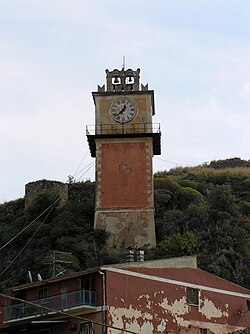Cassano allo Ionio
| Cassano all'Ionio | ||
|---|---|---|
| Comune | ||
| Comune di Cassano all'Ionio | ||

Clock tower in Cassano
|
||
|
||
| Location of Cassano all'Ionio in Italy | ||
| Coordinates: 39°47′N 16°19′E / 39.783°N 16.317°E | ||
| Country | Italy | |
| Region | Calabria | |
| Province / Metropolitan city | Cosenza (CS) | |
| Frazioni | Doria, Lauropoli, Sibari | |
| Government | ||
| • Mayor | Emanuela Greco (commissar) | |
| Area | ||
| • Total | 154 km2 (59 sq mi) | |
| Elevation | 250 m (820 ft) | |
| Population (December 2013) | ||
| • Total | 18,652 | |
| • Density | 120/km2 (310/sq mi) | |
| Demonym(s) | Cassanesi | |
| Time zone | CET (UTC+1) | |
| • Summer (DST) | CEST (UTC+2) | |
| Postal code | 87011 | |
| Dialing code | 0981 | |
| Patron saint | Santissimo Crocifisso | |
| Saint day | First Friday in March | |
| Website | Official website | |
Cassano all'Ionio, also named Cassano allo Ionio, is a town and comune in province of Cosenza of Calabria, southern Italy, known in Roman times as Cassanum. It lies in a fertile region in the concave recess of a steep mountain, 60 km northeast of the town of Cosenza, 10 km west of the archaeological site of Sybaris.
Cassano was the site of great Saracen defeat of the Byzantine forces in Italy under Pothos in 1031.
The diocese of Cassano was first mentioned in 1059.
The rock above the city is crowned by a medieval castle commanding beautiful views. Its tower is still believed to be that from which the stone was thrown that killed Milo. There are warm sulfurous springs here, which are used for baths.
The archaeological site of Sybaris, located near the modern town of Sibari, is part of the comune of Cassano allo Ionio.
...
Wikipedia


